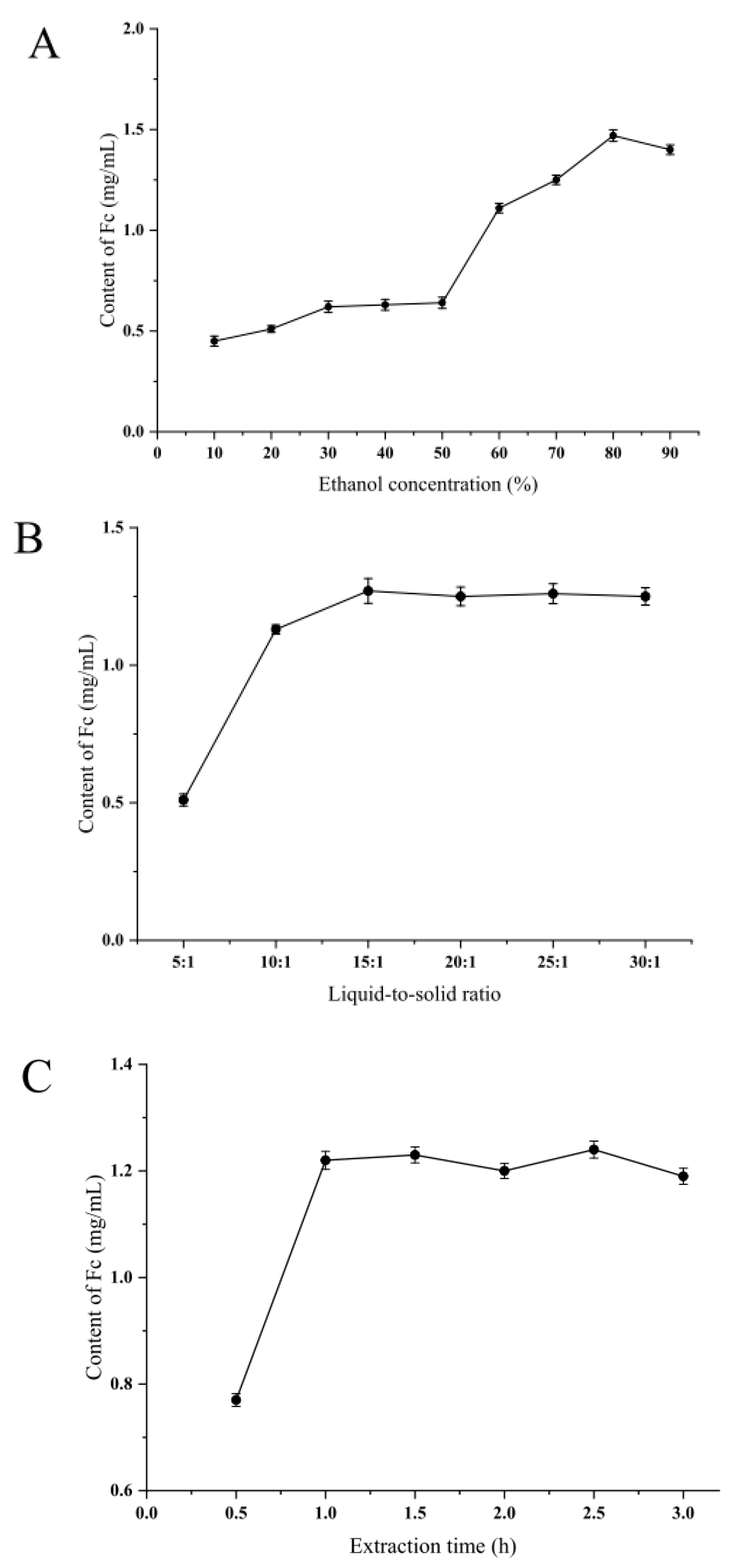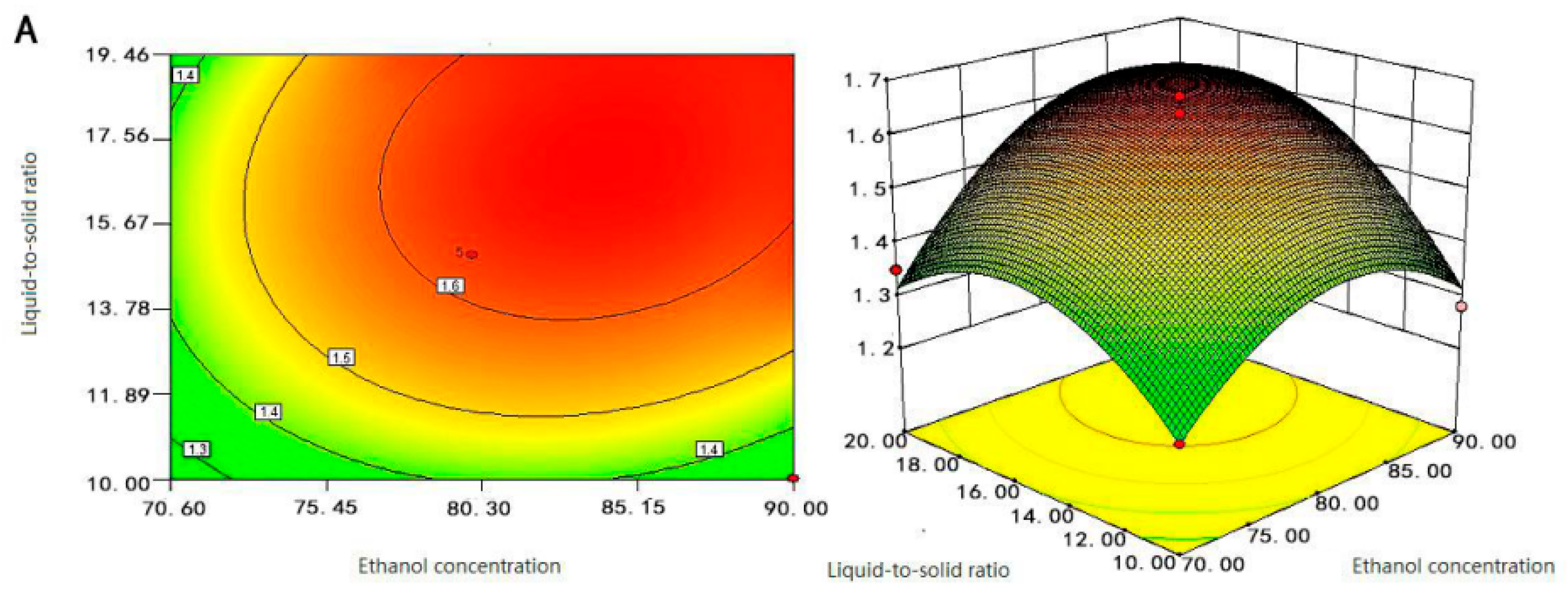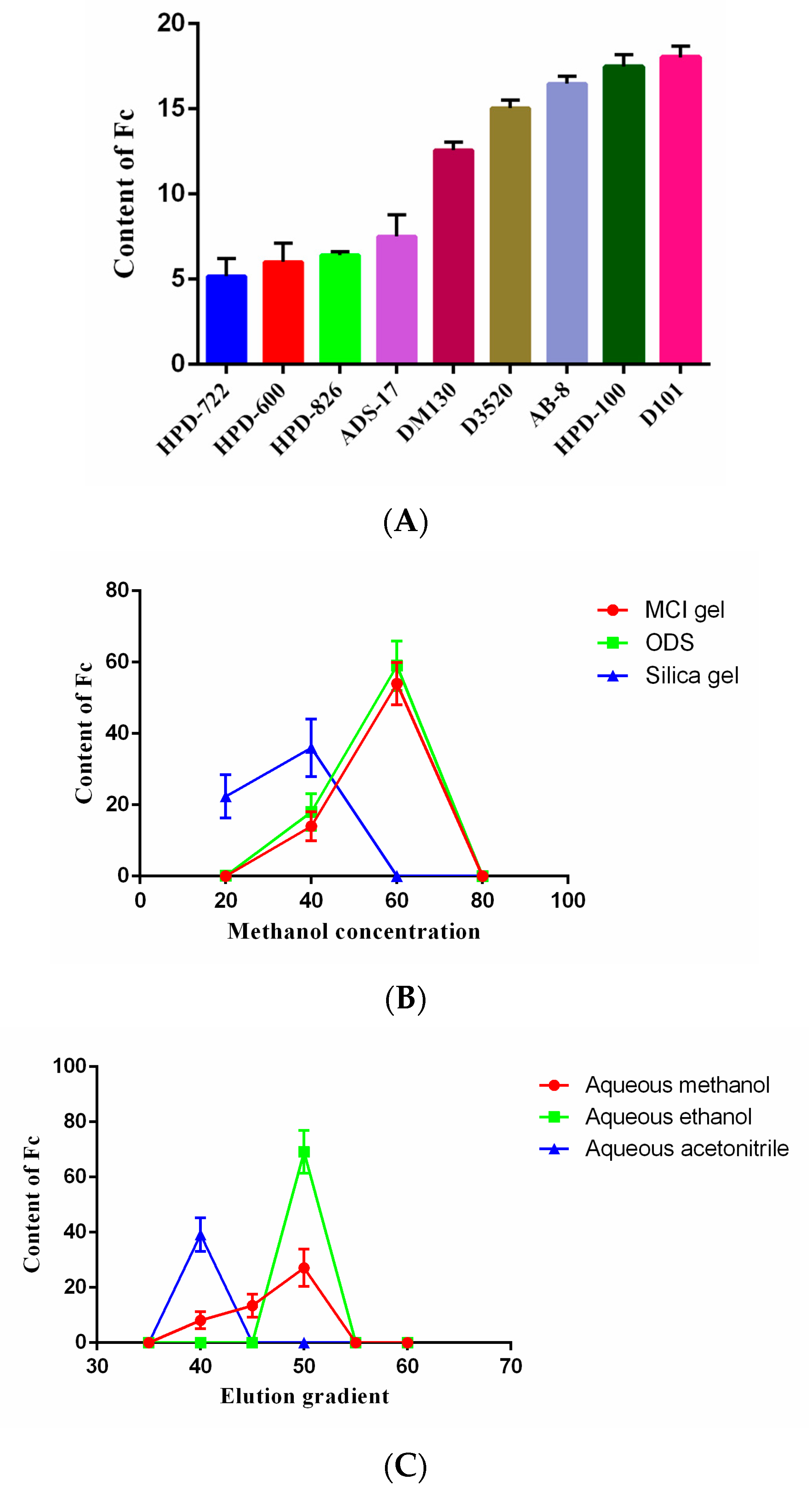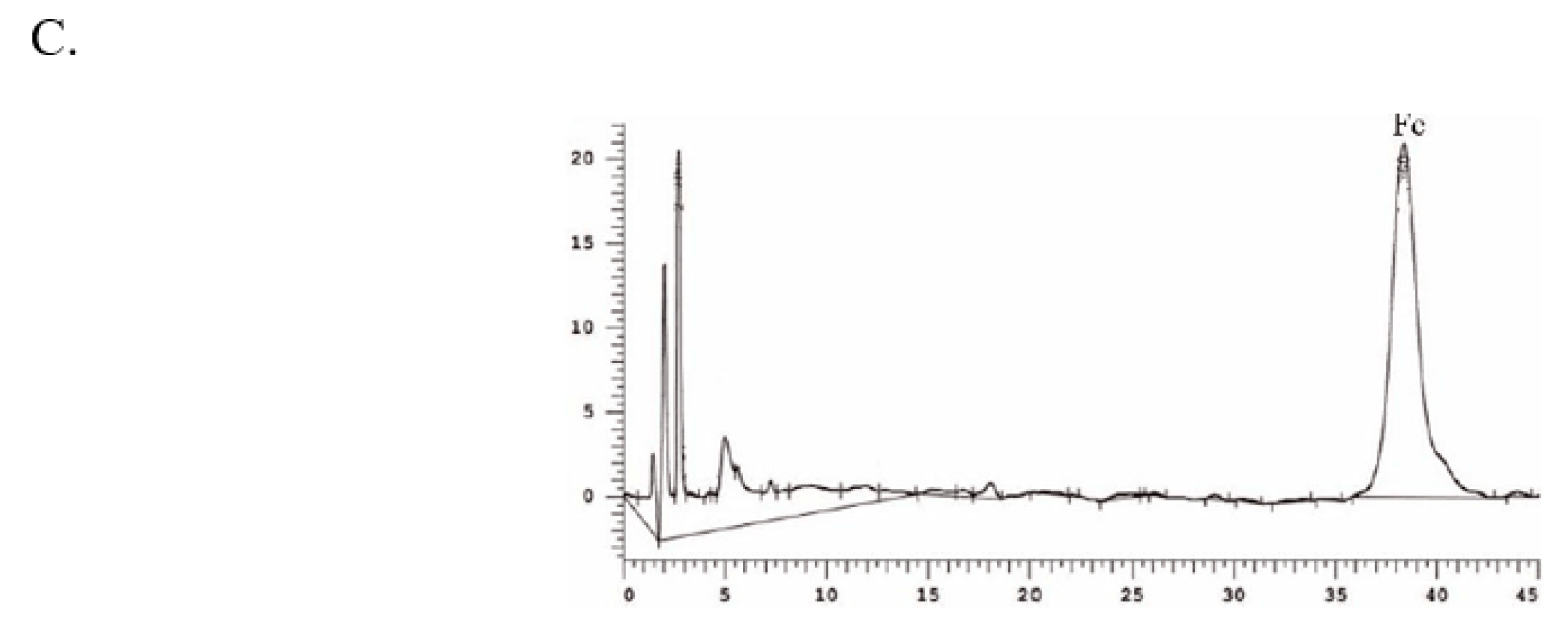Optimization of Extraction and Separation Process of Notoginsenoside Fc from Panax notoginseng Leaves
Abstract
:1. Introduction
2. Results
2.1. Single Factor Experiment
2.2. Optimisation of UAE Condition
2.2.1. Analysis of Response Surface Model
2.2.2. Interactions of Different Experimental Factors on the Effects of Response Variables
2.2.3. Determination and Validation of Optimized UAE Condition
2.3. Optimum Macroporous Resin
2.4. Determination of Secondary Separation Column Chromatography
2.5. Effect of Different Elution Solvents on ODS
2.6. The Optimal Separation Process and HPLC Analysis of Notoginsenoside Fc in P. notoginseng Leaves
3. Materials and Methods
3.1. Materials
3.2. Extraction Process
3.3. Experimental Design and Statistical Model
3.4. HPLC Analysis
3.5. Seperation Process of Notoginsenoside Fc
3.5.1. Selection of Macroporous Resins for Preliminary Separation of Fc
3.5.2. Selection of Secondary Separation Column Chromatography
3.5.3. Effect of Different Elution Solvents on ODS
3.5.4. Separation Process
3.6. Crystallization of Notoginsenoside Fc
4. Conclusions
Author Contributions
Funding
Institutional Review Board Statement
Informed Consent Statement
Data Availability Statement
Acknowledgments
Conflicts of Interest
Sample Availability
References
- Duan, L.; Xiong, X.; Hu, J.; Liu, Y.; Wang, J. Efficacy and safety of oral Panax notoginseng saponins for unstable angina patients: A meta-analysis and systematic review. Phytomedicine 2018, 47, 23–33. [Google Scholar] [CrossRef]
- Zhang, J.P.; Si, Y.C.; Zhu, P.C. Effect of total saponins on the proliferation and differentiation of neural stem cells in hippocampus of rats in vitro. Acta Anat. Sin. 2010, 41, 362–366. [Google Scholar]
- Gu, C.Z.; Qiao, Y.J.; Wang, D.; Zhu, H.T.; Yang, C.R.; Xu, M.; Zhang, Y.J. New triterpenoid saponins from the steaming treated roots of Panax notoginseng. Nat. Prod. Res. 2017, 32, 294–301. [Google Scholar] [CrossRef] [PubMed]
- He, C.Y.; Li, J.; Xu, N.S.; Wang, R.F.; Li, Z.Y.; Yang, L.; Wang, Z.T. Pharmacokinetics, bioavailability, and metabolism of Notoginsenoside Fc in rats by liquid chromatography/electrospray ionization tandem mass spectrometry. J. Pharm. Biomed. 2017, 109, 150–157. [Google Scholar] [CrossRef]
- Liu, J.J.; Jiang, C.Y.; Ma, X.; Wang, J.B. Notoginsenoside Fc attenuates high glucose-induced vascular endothelial cell injury via upregulation of PPAR-γ in diabetic Sprague-Dawley rats. Vasc. Pharmacol. 2018, 109, 27–35. [Google Scholar] [CrossRef] [PubMed]
- Wei, M.M.; Gao, Y.C.; Cheng, D.S.; Zhang, H.Y.; Zhang, W.; Shen, Y.L.; Huang, Q.W.; An, X.N.; Wang, B.; Yu, Z.H.; et al. Notoginsenoside Fc ameliorates renal tubular injury and mitochondrial damage in acetaminophen-induced acute kidney injury partly by regulating SIRT3/SOD2 pathway. Front. Med. 2023, 9, 1055252. [Google Scholar] [CrossRef]
- Liu, J.J.; Jiang, C.Y.; Ma, X.; Feng, L.S.; Wang, J.B. Notoginsenoside Fc Accelerates Reendothelialization following Vascular Injury in Diabetic Rats by Promoting Endothelial Cell Autophagy. J. Diabetes Res. 2019, 2019, 9696521. [Google Scholar] [CrossRef] [PubMed]
- Liu, Y.Q.; Liu, T.Y.; Ding, K.V.; Liu, Z.Y.; Li, Y.Y.; He, T.T.; Zhang, W.M.; Fan, Y.P.; Ma, W.R.; Cui, L.; et al. Phospholipase Cγ2 Signaling Cascade Contribute to the Antiplatelet Effect of Notoginsenoside Fc. Front. Pharmacol. 2018, 9, 1293. [Google Scholar] [CrossRef] [PubMed]
- Cheok, C.Y.; Salman, H.A.K.; Sulaiman, R. Extraction and quantification of saponins: A review. Food Res. Int. 2014, 59, 16–40. [Google Scholar] [CrossRef]
- Böttcher, S.; Drusch, S. Saponins—Self-assembly and behavior at aqueous interfaces. Adv. Colloid Interface Sci. 2017, 243, 105–113. [Google Scholar] [CrossRef] [PubMed]
- Navarro, D.H.; Joaquin, H.T.; Fornari, T.; Reglero, G.; Martin, D. The gastrointestinal behavior of saponins and its significance for their bioavailability and bioactivities. J. Funct. Foods. 2018, 40, 484–497. [Google Scholar] [CrossRef]
- Li, F.; Lv, C.N.; Li, Q.; Wang, J.; Song, D.; Liu, P.P.; Zhang, D.D.; Lu, J.C. Chemical and bioactive comparison of flowers of Panax ginseng, Meyer, Panax quinquefolius, L. and Panax notoginseng, Burk. J. Ginseng Res. 2017, 41, 487–495. [Google Scholar] [CrossRef] [PubMed]
- He, A.; Dong, B.; Feng, X.T.; Yao, S. Extraction of bioactive ginseng saponins using aqueous two-phase systems of ionic liquids and salts. Sep. Purif. Technol. 2018, 196, 270–280. [Google Scholar] [CrossRef]
- Wang, Q.Y.; Dong, X.; Yang, J.; Hu, Y.H.; Cao, J. Vesicle based ultrasonic-assisted extraction of saponins inPanax notoginseng. Food Chem. 2019, 303, 125394. [Google Scholar] [CrossRef] [PubMed]
- Bitencourt, R.G.; Queiroga, C.L.; Junior, Í.M.; Cabral, F.A. Fractionated extraction of saponins from Brazilian ginseng by sequential process using supercritical CO2, ethanol and water. J. Supercrit. Fluids 2014, 92, 272–281. [Google Scholar] [CrossRef]
- Vilkhu, K.; Mawson, R.; Simons, L.; Bates, D. Application and opportunities for ultrasound assisted extraction in the food industry. review. Innov. Food Sci. Emerg. 2008, 9, 161–169. [Google Scholar] [CrossRef]
- Zhang, Z.F.; Liu, Y.; Luo, P.; Zhang, H. Separation and purification of two flavone glucuronides from erigeron multiradiatus (Lindl.) Benth with macroporous resins. J. Biomed. Biotechnol. 2009, 2009, 875629. [Google Scholar] [CrossRef] [PubMed]
- Peng, M.; Yi, Y.X.; Zhang, T.; Ding, Y.; Le, J. Stereoisomers of Saponins in Panax notoginseng (Sanqi): A Review. Front. Pharmacol. 2018, 9, 1663–9812. [Google Scholar] [CrossRef] [PubMed]
- Yin, L.H.; Xu, Y.W.; Qi, Y.; Han, X.; Xu, L.N.; Peng, J.Y.; Sun, C.K. A green and efficient protocol for industrial-scale preparation of dioscin from Dioscorea nipponica Makino by two-step macroporous resin column chromatography. Chem. Eng. J. 2010, 165, 281–289. [Google Scholar] [CrossRef]
- Li, X.J.; Fu, Y.J.; Luo, M.; Wang, W.; Zhang, L.; Zhao, C.J.; Zu, Y.G. Preparative separation of dryofragin and aspidin BB from Dryopteris fragrans extracts by macroporous resin column chromatography. J. Pharm. Biomed. 2012, 61, 199–206. [Google Scholar] [CrossRef] [PubMed]
- Weremfo, A.; Abassah-Oppong, S.; Adulley, F.; Dabie, K.; Seidu-Larry, S. Response surface methodology as a tool to optimize the extraction of bioactive compounds from plant sources. J. Sci. Food Agric. 2023, 103, 26–36. [Google Scholar] [CrossRef] [PubMed]
- Chang, K.H.; Jee, H.S.; Lee, N.K.; Park, S.H.; Lee, N.W.; Park, H.D. Optimization of the enzymatic production of 20(S)-ginsenoside Rg3 from white ginseng extract using response surface methodology. New Biotechnol. 2009, 26, 181–186. [Google Scholar] [CrossRef] [PubMed]
- Luo, X.H.; Bai, R.L.; Zhen, D.H.; Yang, Z.B.; Huang, D.N.; Mao, H.L.; Li, X.F.; Zou, H.T.; Xiang, Y.; Liu, K.L.; et al. Response surface optimization of the enzyme-based ultrasound-assisted extraction of acorn tannins and their corrosion inhibition properties. Ind. Crops Prod. 2019, 129, 405–413. [Google Scholar] [CrossRef]
- Luo, Z.H.; Guo, Z.H.; Xiao, T.; Su, G.Y.; Zhao, Y.Q. Enrichment of total flavones and licochalcone A from licorice residues and its hypoglycemic activity. J. Chromatogr. B 2019, 1114–1115, 134–145. [Google Scholar] [CrossRef] [PubMed]
- Wang, Z.; Chen, Y.Y.; Pan, H.J.; Wei, L.; Wang, Y.H.; Zeng, C.H. Saponin Accumulation in Flower Buds of Panax notoginseng. Chin. Herb. Med. 2015, 7, 179–184. [Google Scholar] [CrossRef]
- Gong, X.; Chen, H.; Pan, J.; Qu, H. Optimization of Panax notoginseng extraction process using a design space approach. Sep. Purif. Technol. 2015, 141, 197–206. [Google Scholar] [CrossRef]
- Dai, C.Y.; Liao, P.R.; Zhao, M.Z.; Gong, C.; Dang, Y.; Qu, Y.; Qiu, L.S. Optimization of Ultrasonic Flavonoid Extraction from Saussurea involucrate, and the Ability of Flavonoids to Block Melanin Deposition in Human Melanocytes. Molecules 2020, 25, 313. [Google Scholar] [CrossRef] [PubMed]
- Zhou, S.S.; Jiang, N.; Zhang, M.; Xiao, X.; Liu, Z.Y.; Xu, X.H.; Gao, Q.H.; Lv, W.L. Analyzing Active Constituents and Optimal Steaming Conditions Related to the Hematopoietic Effect of Steamed Panax notoginseng by Network Pharmacology Coupled with Response Surface Methodology. Biomed. Res. Int. 2020, 2020, 9371426. [Google Scholar] [CrossRef] [PubMed]
- Dardavila, M.M.; Pappou, S.; Savvidou, M.G.; Louli, V.; Katapodis, P.; Stamatis, H.; Magoulas, K.; Voutsas, E. Extraction of Bioactive Compounds from C. vulgaris Biomass Using Deep Eutectic Solvents. Molecules 2023, 28, 415. [Google Scholar] [CrossRef] [PubMed]
- Belhachat, D.; Mekimene, L.; Belhachat, M.; Ferradji, A.; Aid, F. Application of response surface methodology to optimize the extraction of essential oil from ripe berries of Pistacia lentiscus using ultrasonic pretreatment. J. Appl. Res. Med. Aromat. 2018, 9, 132–140. [Google Scholar] [CrossRef]
- Durante, M.; Ferramosca, A.; Treppiccione, L.; Di, G.M.; Zara, V.; Montefusco, A.; Piro, G.; Mita, G.; Bergamo, P.; Lenucci, M.S. Application of response surface methodology (RSM) for the optimization of supercritical CO2 extraction of oil from patè olive cake: Yield, content of bioactive molecules and biological effects in vivo. Food Chem. 2020, 332, 127405. [Google Scholar] [CrossRef] [PubMed]
- Buang, F.; Jantan, I.; Amran, A.Z.; Arbain, D. Optimization of ginger (Zingiber officinale) oil yield from malaysia in different hydrodistillation physical parameters via central composite design of response surface methodology (RSM). Res. J. Appl. Sci. Eng. Technol. 2014, 7, 5098–5105. [Google Scholar] [CrossRef]
- Zhong, K.; Wang, Q. Optimization of ultrasonic extraction of polysaccharides from dried longan pulp using response surface methodology. Carbohydr. Polym. 2010, 80, 19–25. [Google Scholar] [CrossRef]
- Zhang, M.M.; Wei, D.N.; He, L.; Wang, D.; Wang, L.; Tang, D.D.; Zhao, R.; Ye, X.; Wu, C.J.; Peng, W. Application of response surface methodology (RSM) for optimization of the supercritical CO2 extract of oil from Zanthoxylum bungeanum pericarp: Yield, composition and gastric protective effect. Food Chem. X 2022, 15, 100391. [Google Scholar] [CrossRef]
- Fang, L.; Ni, M.; Xia, F.B.; Peng, L.; He, C.; Wu, Z.; Wan, J.B. preparative separation of minor saponins from Panax notoginseng leaves using biotransformation, macroporous resins, and preparative high-performance liquid chromatography. J. Ginseng Res. 2019, 43, 105–115. [Google Scholar]
- Wu, Y.F.; Zhang, L.; Mao, J.W.; Liu, S.W.; Huang, J.; You, Y.R.; Mei, L.H. Kinetic and thermodynamic studies of sulforaphane adsorption on macroporous resin. J. Chromatogr. B Anal. Technol. Biomed. Life Sci. 2016, 1028, 231–236. [Google Scholar]
- Zheng, Y.K.; Miao, C.P.; Chen, Y.H.; Huang, F.F.; Xia, Y.M.; Chen, Y.W.; Zhao, L.X. Endophytic fungi harbored in Panax notoginseng: Diversity and potential as biological control agents against host plant pathogens of root-rot disease. J. Ginseng Res. 2017, 41, 353–360. [Google Scholar] [CrossRef] [PubMed]
- Nie, W.; Luo, J.; Wang, X.; Wan, X.; Kong, L. An insight into enrichment and separation of oleanane-type triterpenoid saponins by various chromatographic materials. Sep. Purif. Technol. 2009, 65, 243–247. [Google Scholar] [CrossRef]








| Source | Sum of Squares | Df | Mean Square | F Value | p-Value | ||
|---|---|---|---|---|---|---|---|
| model | 1.22 | 9 | 0.14 | 57.94 | <0.0001 | Significant | ** |
| X1 | 0.065 | 1 | 0.065 | 27.62 | 0.0012 | ** | |
| X2 | 0.065 | 1 | 0.065 | 27.2 | 0.0012 | ** | |
| X3 | 0.45 | 1 | 0.45 | 192.37 | <0.0001 | ** | |
| X1X2 | 9.025 × 10−3 | 1 | 9.025 × 10−3 | 3.85 | 0.0906 | ||
| X1X3 | 0.011 | 1 | 0.011 | 4.70 | 0.0668 | ||
| X2X3 | 0.051 | 1 | 0.076 | 21.58 | 0.0024 | * | |
| 0.076 | 1 | 0.076 | 32.35 | 0.0007 | ** | ||
| 0.070 | 1 | 0.070 | 29.99 | 0.0009 | ** | ||
| 0.38 | 1 | 0.38 | 160.74 | <0.0001 | ** | ||
| Residual | 0.016 | 7 | 2.346 × 10−3 | ||||
| Lack of Fit | 0.012 | 3 | 4.033 × 10−3 | 3.73 | 0.1178 | Not Significant | |
| Pure Error | 4.320 × 10−3 | 4 | 1.080 × 10−3 | ||||
| Cor Total | 1.24 | 16 | |||||
| Std.Dev | 0.048 | ||||||
| Mean | 1.36 | R2 | 0.9868 | ||||
| C.V.% | 3.56 | Adj R2 | 0.9697 | ||||
| PRESS | 0.20 |
| Run | Ethanol Concentration (%)—X1 | Solid to Solvent Ratio (ml/g)—X2 | Extraction Time (h)–X3 | Fc Content (mg/g) |
|---|---|---|---|---|
| 1 | 90 | 20 | 1 | 15.9 |
| 2 | 80 | 15 | 1 | 16.7 |
| 3 | 80 | 15 | 1 | 16.4 |
| 4 | 90 | 15 | 1.5 | 16.2 |
| 5 | 70 | 10 | 1 | 12.3 |
| 6 | 90 | 10 | 1 | 12.8 |
| 7 | 80 | 10 | 0.5 | 10.3 |
| 8 | 80 | 15 | 1 | 16 |
| 9 | 70 | 15 | 0.5 | 8.7 |
| 10 | 90 | 15 | 0.5 | 9.8 |
| 11 | 80 | 20 | 0.5 | 9.5 |
| 12 | 80 | 10 | 1.5 | 12.2 |
| 13 | 80 | 15 | 1 | 16.2 |
| 14 | 70 | 15 | 1.5 | 13 |
| 15 | 80 | 15 | 1 | 15.8 |
| 16 | 80 | 20 | 1.5 | 15.9 |
| 17 | 70 | 20 | 1 | 13.5 |
| Macroporous Resin | Polarity | Surface Area (m2/g) | Average Pore Diameter (nm) | Particle Diameter (mm) |
|---|---|---|---|---|
| AB-8 | Weak-polar | 480–520 | 130–140 | 0.3–1.25 |
| D101 | Non-polar | 400–600 | 100–110 | 0.3–1.25 |
| HPD100 | Non-polar | 650–700 | 85–90 | 0.3–1.2 |
| HPD600 | polar | 550–600 | 80 | 0.3–1.2 |
| D3520 | Non-polar | 480–520 | 85–90 | 0.3–1.25 |
| HPD826 | Weak-polar | 500–600 | 9–10 | 0.3–1.25 |
| ADS-17 | Weak-polar | 90–150 | 25–30 | 0.3–1.25 |
| HPD722 | Weak-polar | 485–530 | 13.0–14.0 | 0.30–1.25 |
| DM130 | Weak-polar | 500–550 | 9.0–10.0 | 0.25–0.84 |
Disclaimer/Publisher’s Note: The statements, opinions and data contained in all publications are solely those of the individual author(s) and contributor(s) and not of MDPI and/or the editor(s). MDPI and/or the editor(s) disclaim responsibility for any injury to people or property resulting from any ideas, methods, instructions or products referred to in the content. |
© 2023 by the authors. Licensee MDPI, Basel, Switzerland. This article is an open access article distributed under the terms and conditions of the Creative Commons Attribution (CC BY) license (https://creativecommons.org/licenses/by/4.0/).
Share and Cite
Guo, Z.; Luo, Z.; Wu, S.; Yang, C.; Xiao, T.; Zhao, Y. Optimization of Extraction and Separation Process of Notoginsenoside Fc from Panax notoginseng Leaves. Molecules 2023, 28, 3915. https://doi.org/10.3390/molecules28093915
Guo Z, Luo Z, Wu S, Yang C, Xiao T, Zhao Y. Optimization of Extraction and Separation Process of Notoginsenoside Fc from Panax notoginseng Leaves. Molecules. 2023; 28(9):3915. https://doi.org/10.3390/molecules28093915
Chicago/Turabian StyleGuo, Zhenghong, Zhonghua Luo, Shao Wu, Chunhong Yang, Ting Xiao, and Yuqing Zhao. 2023. "Optimization of Extraction and Separation Process of Notoginsenoside Fc from Panax notoginseng Leaves" Molecules 28, no. 9: 3915. https://doi.org/10.3390/molecules28093915





